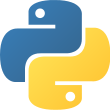 Language
Language
- Python 2
 Reading time
Reading time
- Approximately 48 days
 What you will learn
What you will learn
- Natural Language Processing
 Author
Author
- Jalaj Thanaki
 Published
Published
- 8 years, 5 months ago
 Packages you will be introduced to
Packages you will be introduced to
- nltk
- polyglot
- pycorenlp
- scikit-learn
- gensim
- numpy
- pandas
Key Features
- Implement Machine Learning and Deep Learning techniques for efficient natural language processing
- Get started with NLTK and implement NLP in your applications with ease
- Understand and interpret human languages with the power of text analysis via Python
Book Description
This book starts off by laying the foundation for Natural Language Processing and why Python is one of the best options to build an NLP-based expert system with advantages such as Community support, availability of frameworks and so on. Later it gives you a better understanding of available free forms of corpus and different types of dataset. After this, you will know how to choose a dataset for natural language processing applications and find the right NLP techniques to process sentences in datasets and understand their structure. You will also learn how to tokenize different parts of sentences and ways to analyze them.
During the course of the book, you will explore the semantic as well as syntactic analysis of text. You will understand how to solve various ambiguities in processing human language and will come across various scenarios while performing text analysis.
You will learn the very basics of getting the environment ready for natural language processing, move on to the initial setup, and then quickly understand sentences and language parts. You will learn the power of Machine Learning and Deep Learning to extract information from text data.
By the end of the book, you will have a clear understanding of natural language processing and will have worked on multiple examples that implement NLP in the real world.
What you will learn
- Focus on Python programming paradigms, which are used to develop NLP applications
- Understand corpus analysis and different types of data attribute.
- Learn NLP using Python libraries such as NLTK, Polyglot, SpaCy, Standford CoreNLP and so on
- Learn about Features Extraction and Feature selection as part of Features Engineering.
- Explore the advantages of vectorization in Deep Learning.
- Get a better understanding of the architecture of a rule-based system.
- Optimize and fine-tune Supervised and Unsupervised Machine Learning algorithms for NLP problems.
- Identify Deep Learning techniques for Natural Language Processing and Natural Language Generation problems.
About the Author
Jalaj Thanaki is a data scientist by profession and data science researcher by practice. She likes to deal with data science related problems. She wants to make the world a better place using data science and artificial intelligence related technologies. Her research interest lies in natural language processing, machine learning, deep learning, and big data analytics. Besides being a data scientist, Jalaj is also a social activist, traveler, and nature-lover.
Table of Contents
- Introduction
- Practical Understanding of a Corpus and Dataset
- Understanding the Structure of a Sentences
- Preprocessing
- Feature Engineering and NLP Algorithms
- Advanced Feature Engineering and NLP Algorithms
- Rule-Based System for NLP
- Machine Learning for NLP Problems
- Deep Learning for NLU and NLG Problems
- Advanced Tools
- How to Improve Your NLP Skills
- Installation Guide
